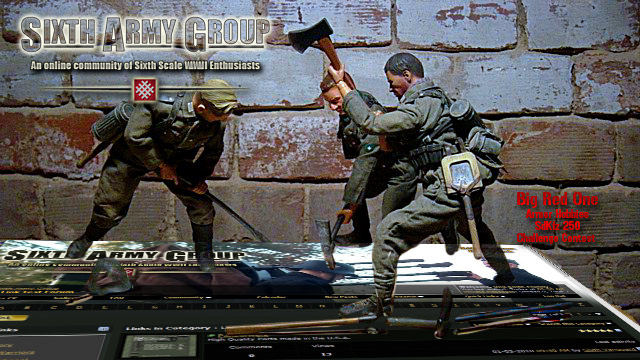Tony Barton
Company Commander
Although my interest normally ends at 1945 , I always had a slight hankering to do a Gloster in Korea .
I recently read Max Hastings’ book on the Korean War, and that was enough to get me started. One thing led to another, and making the 1944 equipment for him has also led to a look at the Malayan Emergency . Both wars were really the aftermath of colonialism , with the Communists trying to gain power . They half-succeeded in Korea , but failed in Malaya.
To make the figure , the difficult bit was to create the 1944 webbing .
The British Army had started using webbing during the Boer War, and by 1908 had issued probably the best set of equipment around. It was replaced with the 1937 equipment , in many ways an inferior design,which continued in use well into the 1950s . By the end of WW2 there was an attempt to make a lighter, tougher and better designed version, in view of the experience of fighting in Burma, and with an expected two year campaign against the Japanese in prospect. That campaign fortunately never happened, but the 1944 webbing was made, and issued for all campaigns in the East, including the Korean War and the Malayan conflict .
The set was made of thinner rotproof webbing with larger ammo pouches, a new haversack/backpack, and a US type waterbottle. The belt and braces were new designs, with better weight distribution, and all the buckles were of treated alloy. Anyone interested in British Equipment should visit the wonderful karkeeweb site :~
http://www.karkeeweb.com/index.html#home
Making it in miniature has been slightly tricky, since there is no exact match to the fittings in etched brass available. I have used some Elbourne 1937 fittings, and some of Armorpax’s smallest, especially to make the “ Quick release “ buckles. The tape is from my own store , the haversack a combination of a scratch central pack and two BBI pouches .
The US-type waterbottles are carried in scratchbuilt carriers .
All the tape and canvas are prepainted, and the fittings have been lightly sanded then immersed in black antiquing fluid, which chemically stains them.
The belt is made in three sections, with a row of eyelets along the bottom edge to hang things from, copied from US belts.
The first use was by the Paras right at the end of WW2, in the reoccupation of Indonesia.

*******************************************************************
Private, Ist Gloucestershire Regiment, Imjin river April 1951.
The 29th Brigade, made up of the Northumberland Fusiliers, the 1st Glosters, the 1st Royal Ulster Rifles and a Belgian Battalion were sent to Korea as part of the UN response to the North Korean invasion.
{ Non-British readers : “ Gloucestershire “ is the name of the County. It’s pronounced ” Glostersher”, and “ Gloster “ was often the preferred spelling when referring to the Regiment.
Just to be awkward, their shoulder title has the long spelling ! }
They went in 1950, had a miserably cold winter, and in April 1951 were dug in in the hills just behind the Imjin river trying to stem a massive Chinese offensive .
The Brigade were all heavily engaged, but the Glosters four-day stand against odds was something of an epic, and can be read about in many places.
Most last stands end in massacre, and only 234 escaped , but the astonishing thing is that over 500 ( from 830 ) became prisoners , rather than being killed , while trying to escape once the ammunition had gone . This was deliberate Chinese policy , the idea being to re-educate the captives.
After two miserable years in POW camps( with daily “re-education” ) they were all released in 1953 .
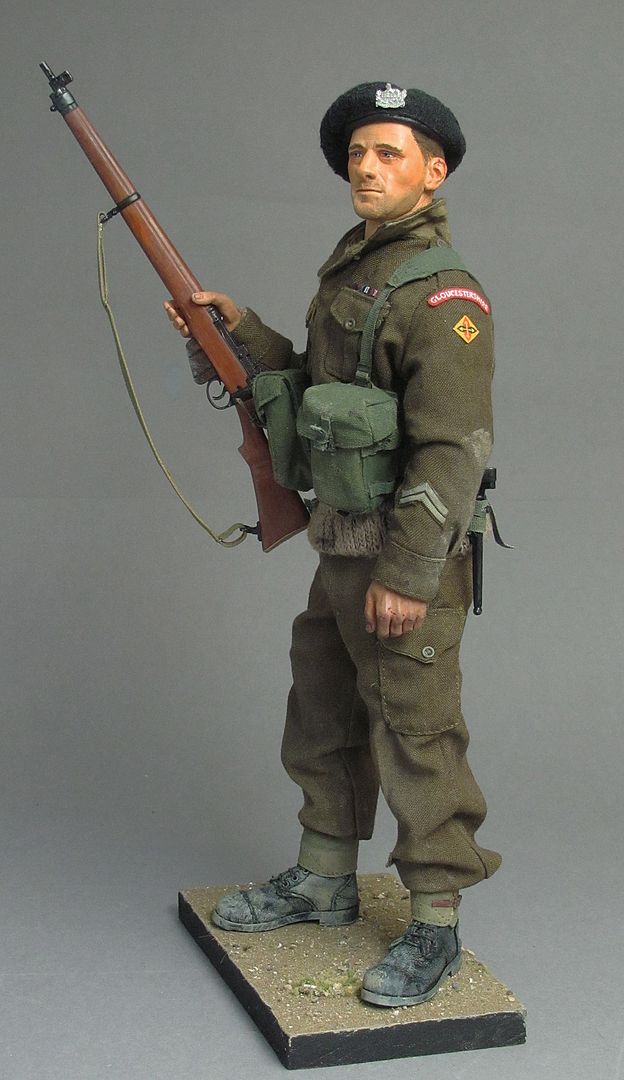
During the savage winter they had been wearing Windproofs and as much US winter clothing as they could scrounge, but by April with warmer weather they were back wearing their Battledress, the 1949 issue with the modernised open collar. The cold weather woolen sweater was a great favourite. Helmets don’t seem to have been much in use, so he’s wearing his blue-black beret with the two badges (small one on the back,which you can’t really see, to commemorate Alexandria 1801 ). He has the 1944 equipment without the haversack. The rifle is the No.4 , with the spike bayonet .
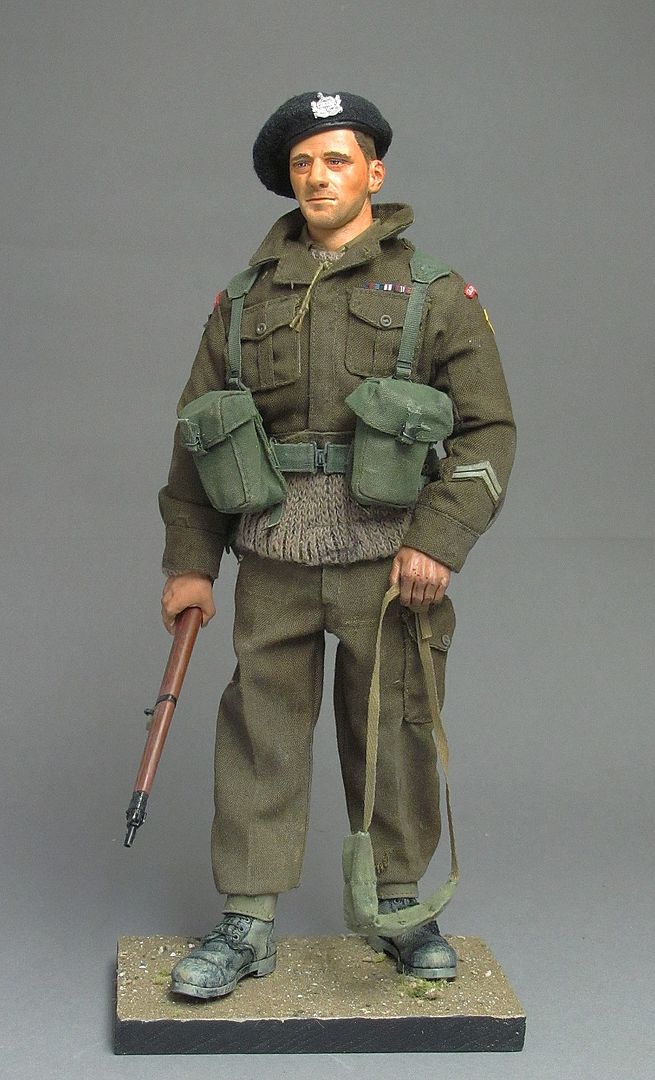
Our man is a veteran of WW2 , a Regular reservist recalled to the Battalion for the emergency .He wears WW2 medal ribbons and good conduct stripes.

The BD is the DiD Montgomery version , with the trouser pockets moved. The boots are from the recent Soldier Story WW2 Chinese figure ironically ! ) excellent. The pullover is from a sock. Rifle is my own resin version.
ironically ! ) excellent. The pullover is from a sock. Rifle is my own resin version.
Beret by Royoboy.

Private, K.O.Y.L.I. , Malaya 1951.
The Malayan Emergency was another anti-Communist campaign, which rather to everyone’s surprise actually succeeded.
It was a very long business, lasting from 1948 to 1960, mostly at a pretty low level, an anti-insurgency rather than a war . As with all such conflicts, a lot of innocent people died .

Most of the troops were National Servicemen , young conscripts doing their bit in a very alien part of the world . The climate , the bugs and diseases , and the absence of any familiar recreations when up-country made it a pretty unpopular posting. Most actions were the result of interminable, mostly fruitless patrols in very dense jungle, with the men often having to carry a lot of food and kit just to stay alive.
They didn’t bother with a lot of ammo, since encounters ( if they happened at all ) were very brief affairs, the CTs wisely running from a surprise fight.
Weapons were varied : our lad has a so-called “ Jungle “ .303”carbine, the No.5, scarcely used in WW2 , but coming into its intended habitat in Malaya. It had a heavy kick and was innacurate at range, but that hardly mattered in the circumstances. The bayonet is the No.9 .
There were Owen guns, Stens and US carbines , and of course Brens, often all the types being carried in a single patrol.
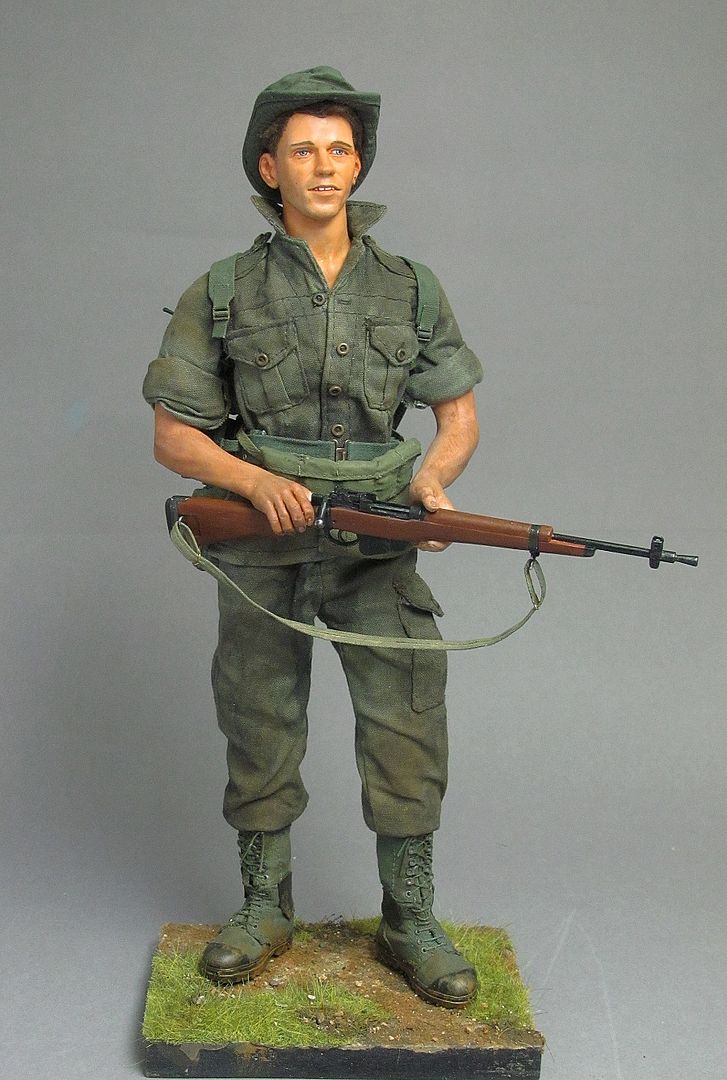
This figure is based on a couple of photos showing the King’s Own Yorkshire Light Infantry on patrol, location not known. For once he’s not hopelessly overburdened, with the 1944 haversack, poncho/bedroll rolled under it, belt with machete, bayonet and waterbottle , but no pouches : his ammo is in the cotton bandolier it was issued in , tied round his waist.
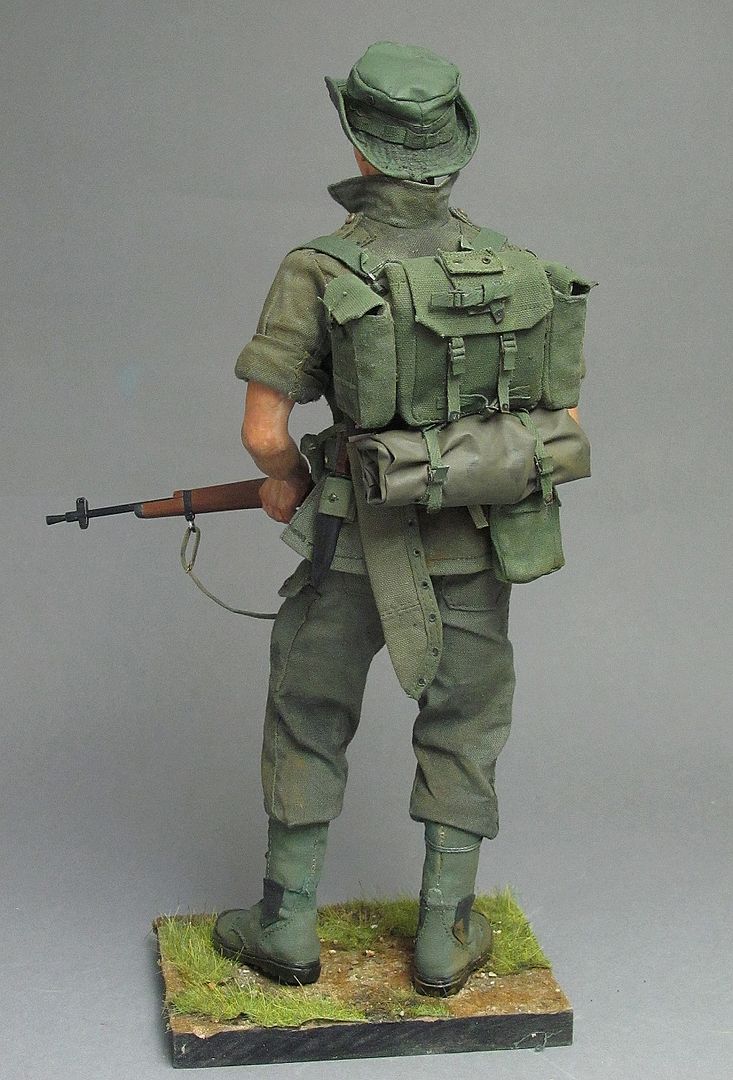
The uniform is from the BBI 1944 uniform, with modifed trousers. There seem to have been at least three issues of JG clothing in use, of different pattern dates: these are the 1950 trousers .
The No.5 rifle is one of my resin No.4s with the front end from the old 21st Century version ( not very good apart from that part ). I had to add the butt pad and the slot for the sling.
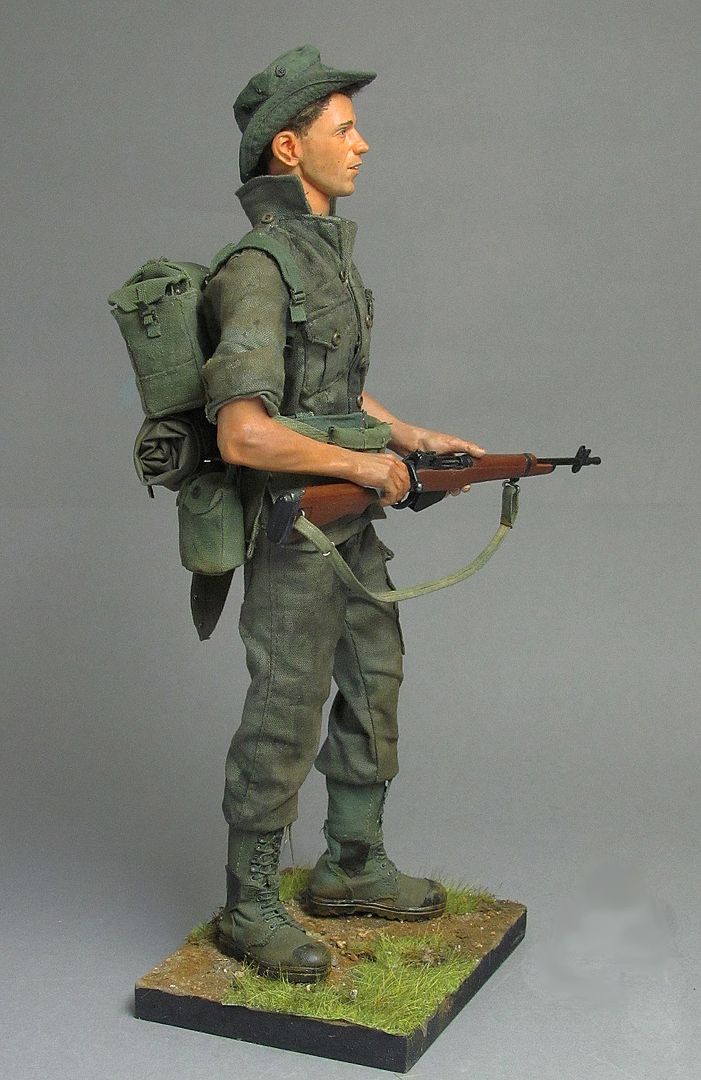
The difficult part was the jungle boots. I opted for the expensive answer of buying a pair of DAK tall boots and a pair of French jungle boots ( both DiD ), and joining the uppers of one to the foot of the other. The join is not obvious , partly hidden by little paint and some black rubber anklebone patches. I can’t see how it could otherwise be done, since the combination of eyelets and lacing hooks is far too complex to scratchbuild.
The hat is a US night camo one repainted, and ventilators and the looped band added. And yes, they did wear them like that.....and in lots of other eccentric ways.


I recommend the Osprey, M.A.A No.132, written and illustrated by men who were there.
Thanks to Richie Elbourne and Royoboy for their help, as ever.
*****************************************************************************************************
I recently read Max Hastings’ book on the Korean War, and that was enough to get me started. One thing led to another, and making the 1944 equipment for him has also led to a look at the Malayan Emergency . Both wars were really the aftermath of colonialism , with the Communists trying to gain power . They half-succeeded in Korea , but failed in Malaya.
To make the figure , the difficult bit was to create the 1944 webbing .
The British Army had started using webbing during the Boer War, and by 1908 had issued probably the best set of equipment around. It was replaced with the 1937 equipment , in many ways an inferior design,which continued in use well into the 1950s . By the end of WW2 there was an attempt to make a lighter, tougher and better designed version, in view of the experience of fighting in Burma, and with an expected two year campaign against the Japanese in prospect. That campaign fortunately never happened, but the 1944 webbing was made, and issued for all campaigns in the East, including the Korean War and the Malayan conflict .
The set was made of thinner rotproof webbing with larger ammo pouches, a new haversack/backpack, and a US type waterbottle. The belt and braces were new designs, with better weight distribution, and all the buckles were of treated alloy. Anyone interested in British Equipment should visit the wonderful karkeeweb site :~
http://www.karkeeweb.com/index.html#home
Making it in miniature has been slightly tricky, since there is no exact match to the fittings in etched brass available. I have used some Elbourne 1937 fittings, and some of Armorpax’s smallest, especially to make the “ Quick release “ buckles. The tape is from my own store , the haversack a combination of a scratch central pack and two BBI pouches .
The US-type waterbottles are carried in scratchbuilt carriers .
All the tape and canvas are prepainted, and the fittings have been lightly sanded then immersed in black antiquing fluid, which chemically stains them.
The belt is made in three sections, with a row of eyelets along the bottom edge to hang things from, copied from US belts.
The first use was by the Paras right at the end of WW2, in the reoccupation of Indonesia.

*******************************************************************
Private, Ist Gloucestershire Regiment, Imjin river April 1951.
The 29th Brigade, made up of the Northumberland Fusiliers, the 1st Glosters, the 1st Royal Ulster Rifles and a Belgian Battalion were sent to Korea as part of the UN response to the North Korean invasion.
{ Non-British readers : “ Gloucestershire “ is the name of the County. It’s pronounced ” Glostersher”, and “ Gloster “ was often the preferred spelling when referring to the Regiment.
Just to be awkward, their shoulder title has the long spelling ! }
They went in 1950, had a miserably cold winter, and in April 1951 were dug in in the hills just behind the Imjin river trying to stem a massive Chinese offensive .
The Brigade were all heavily engaged, but the Glosters four-day stand against odds was something of an epic, and can be read about in many places.
Most last stands end in massacre, and only 234 escaped , but the astonishing thing is that over 500 ( from 830 ) became prisoners , rather than being killed , while trying to escape once the ammunition had gone . This was deliberate Chinese policy , the idea being to re-educate the captives.
After two miserable years in POW camps( with daily “re-education” ) they were all released in 1953 .

During the savage winter they had been wearing Windproofs and as much US winter clothing as they could scrounge, but by April with warmer weather they were back wearing their Battledress, the 1949 issue with the modernised open collar. The cold weather woolen sweater was a great favourite. Helmets don’t seem to have been much in use, so he’s wearing his blue-black beret with the two badges (small one on the back,which you can’t really see, to commemorate Alexandria 1801 ). He has the 1944 equipment without the haversack. The rifle is the No.4 , with the spike bayonet .

Our man is a veteran of WW2 , a Regular reservist recalled to the Battalion for the emergency .He wears WW2 medal ribbons and good conduct stripes.

The BD is the DiD Montgomery version , with the trouser pockets moved. The boots are from the recent Soldier Story WW2 Chinese figure
 ironically ! ) excellent. The pullover is from a sock. Rifle is my own resin version.
ironically ! ) excellent. The pullover is from a sock. Rifle is my own resin version.Beret by Royoboy.

Private, K.O.Y.L.I. , Malaya 1951.
The Malayan Emergency was another anti-Communist campaign, which rather to everyone’s surprise actually succeeded.
It was a very long business, lasting from 1948 to 1960, mostly at a pretty low level, an anti-insurgency rather than a war . As with all such conflicts, a lot of innocent people died .

Most of the troops were National Servicemen , young conscripts doing their bit in a very alien part of the world . The climate , the bugs and diseases , and the absence of any familiar recreations when up-country made it a pretty unpopular posting. Most actions were the result of interminable, mostly fruitless patrols in very dense jungle, with the men often having to carry a lot of food and kit just to stay alive.
They didn’t bother with a lot of ammo, since encounters ( if they happened at all ) were very brief affairs, the CTs wisely running from a surprise fight.
Weapons were varied : our lad has a so-called “ Jungle “ .303”carbine, the No.5, scarcely used in WW2 , but coming into its intended habitat in Malaya. It had a heavy kick and was innacurate at range, but that hardly mattered in the circumstances. The bayonet is the No.9 .
There were Owen guns, Stens and US carbines , and of course Brens, often all the types being carried in a single patrol.

This figure is based on a couple of photos showing the King’s Own Yorkshire Light Infantry on patrol, location not known. For once he’s not hopelessly overburdened, with the 1944 haversack, poncho/bedroll rolled under it, belt with machete, bayonet and waterbottle , but no pouches : his ammo is in the cotton bandolier it was issued in , tied round his waist.

The uniform is from the BBI 1944 uniform, with modifed trousers. There seem to have been at least three issues of JG clothing in use, of different pattern dates: these are the 1950 trousers .
The No.5 rifle is one of my resin No.4s with the front end from the old 21st Century version ( not very good apart from that part ). I had to add the butt pad and the slot for the sling.

The difficult part was the jungle boots. I opted for the expensive answer of buying a pair of DAK tall boots and a pair of French jungle boots ( both DiD ), and joining the uppers of one to the foot of the other. The join is not obvious , partly hidden by little paint and some black rubber anklebone patches. I can’t see how it could otherwise be done, since the combination of eyelets and lacing hooks is far too complex to scratchbuild.
The hat is a US night camo one repainted, and ventilators and the looped band added. And yes, they did wear them like that.....and in lots of other eccentric ways.


I recommend the Osprey, M.A.A No.132, written and illustrated by men who were there.
Thanks to Richie Elbourne and Royoboy for their help, as ever.
*****************************************************************************************************
